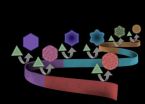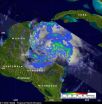(Press-News.org) CHAMPAIGN, Ill. — DNA holds the genetic code for all sorts of biological molecules and traits. But University of Illinois researchers have found that DNA's code can similarly shape metallic structures.
The team found that DNA segments can direct the shape of gold nanoparticles – tiny gold crystals that have many applications in medicine, electronics and catalysis. Led by Yi Lu, the Schenck Professor of Chemistry at the U. of I., the team published its surprising findings in the journal Angewandte Chemie.
"DNA-encoded nanoparticle synthesis can provide us a facile but novel way to produce nanoparticles with predictable shape and properties," Lu said. "Such a discovery has potential impacts in bio-nanotechnology and applications in our everyday lives such as catalysis, sensing, imaging and medicine."
Gold nanoparticles have wide applications in both biology and materials science thanks to their unique physicochemical properties. Properties of a gold nanoparticle are largely determined by its shape and size, so it is critical to be able to tailor the properties of a nanoparticle for a specific application.
"We wondered whether different combinations of DNA sequences could constitute 'genetic codes' to direct the nanomaterial synthesis in a way similar to their direction of protein synthesis," said Zidong Wang, a recent graduate of Lu's group and the first author of the paper.
Gold nanoparticles are made by sewing tiny gold seeds in a solution of gold salt. Particles grow as gold in the salt solution deposits onto the seeds. Lu's group incubated the gold seeds with short segments of DNA before adding the salt solution, causing the particles to grow into various shapes determined by the genetic code of the DNA.
The DNA alphabet comprises four letters: A, T, G and C. The term genetic code refers to the sequence of these letters, called bases. The four bases and their combinations can bind differently with facets of gold nanoseeds and direct the nanoseeds' growth pathways, resulting in different shapes.
In their experiments, the researchers found that strands of repeating A's produced rough, round gold particles; T's, stars; C's, round, flat discs; G's, hexagons. Then the group tested DNA strands that were a combination of two bases, for example, 10 T's and 20 A's. They found that many of the bases compete with each other resulting in intermediate shapes, although A dominates over T.
Next, the researchers plan to investigate exactly how DNA codes direct nanoparticle growth. They also plan to apply their method to synthesize other types of nanomaterials with novel applications.
INFORMATION:
The National Science Foundation supported this work.
Lu also is affiliated with the Beckman Institute for Advanced Science and Technology and with the Frederick Seitz Materials Research Laboratory, both of which are at the U. of I.
Editor's note: To reach Yi Lu, call 217-333-2619; email yi-lu@illinois.edu.
The paper, "Discovery of the DNA 'Genetic Code' for Abiological Gold Nanoparticle Morphologies," is available online.
Oh, my stars and hexagons! DNA code shapes gold nanoparticles
2012-08-09
ELSE PRESS RELEASES FROM THIS DATE:
Student performance improves when teachers given incentives upfront
2012-08-09
A bonus payment to teachers can improve student academic performance — but only when it is given upfront, on the condition that part of the money must be returned if student performance fails to improve, research at the University of Chicago shows.
The study showed that students gained as much as a 10 percentile increase in their scores compared to students with similar backgrounds — if their teacher received a bonus at the beginning of the year, with conditions attached. There was no gain for students when teachers were offered the bonus at the end of the school year, ...
NASA's Aqua satellite sees Tropical Storm Haikui make landfall in China
2012-08-09
Typhoon Haikui weakened to a tropical storm just before landfall in China. Eight hours after landfall, NASA's Aqua satellite still showed a strong and organized tropical storm moving inland.
China's National Meteorological Center (NMC) said that Tropical Storm Haikui, made landfall in Zhejiang province on August 8 at 3:20 a.m. local time (19:20 UTC or 3:20 p.m. EDT/U.S., August 7), about 140 miles (225 km) south of Shanghai. The Joint Typhoon Warning Center's last official warning on Haikui was issued on August 8 at 0300 UTC (11 a.m. local time/Shanghai). At that time ...
NASA sees heavy rainfall and high thunderstorms in Tropical Storm Ernesto
2012-08-09
NASA's TRMM satellite has been measuring the heavy rainfall in Ernesto, and some of the rainfall totals may reach one foot in Central America. NASA's Aqua satellite spotted a large area of the strong thunderstorms generating that heavy rainfall, wrapped around the storm's center. Ernesto made landfall in the Yucatan and is currently tracking west over land.
At 11:15 p.m. EDT on Tuesday, August 7, Belize radar indicated Ernesto made landfall along the southern Yucatan coast near Mahahual, Mexico as a category one hurricane with maximum sustained winds near 85 mph (140 ...
UF researchers discover earliest use of Mexican turkeys by ancient Maya
2012-08-09
GAINESVILLE, Fla. --- A new University of Florida study shows the turkey, one of the most widely consumed birds worldwide, was domesticated more than 1,000 years earlier than previously believed.
Researchers say discovery of the bones from an ancient Mayan archaeological site in Guatemala provides evidence of domestication, usually a significant mark of civilization, and the earliest evidence of the Mexican turkey in the Maya world. The study appears online in PLoS ONE today.
The discovery of the turkey bones is significant because the Maya did not use a lot of domesticated ...
How geckos cope with wet feet
2012-08-09
Geckos are remarkable little creatures, clinging to almost any dry surface, and Alyssa Stark, from the University of Akron, USA, explains that they appear to be equally happy scampering through tropical rainforest canopies as they are in urban settings. 'A lot of work is done on geckos that looks at the very small adhesive structures on their toes to really understand how the system works at the most basic level', says Stark. She adds that the animals grip surfaces with microscopic hairs on the soles of their feet that make close enough contact to be attracted to the surface ...
Doctors can now detect hard-to-diagnose prostate cancer
2012-08-09
NEW YORK (August 9, 2012) -- Researchers have successfully developed and tested a new prostate cancer screening method that uses the combined power of a novel drug therapy and changes in PSA levels over time to identify men with a high PSA who are more likely to have aggressive prostate cancer despite negative biopsies.
The new study by researchers at NewYork-Presbyterian Hospital/Weill Cornell Medical Center, published in the Journal of Urology, shows that PSA can be a much more effective marker for prostate cancer when an additional drug therapy is used than it can ...
Hormone in fruit flies sheds light on diabetes cure, weight-loss drug for humans
2012-08-09
Winston-Salem, N.C. – Manipulating a group of hormone-producing cells in the brain can control blood sugar levels in the body – a discovery that has dramatic potential for research into weight-loss drugs and diabetes treatment.
In a paper published in the October issue of Genetics and available online now, neurobiologists at Wake Forest University examine how fruit flies (Drosophila) react when confronted with a decreased diet.
Reduced diet or starvation normally leads to hyperactivity in fruit flies – a hungry fly buzzes around feverishly, looking for more food. That ...
"The Self Publishers Guide to Book Marketing: Step By Step Guide for Fiction and Non-Fiction Authors" by Jamie Cawley
2012-08-09
Jamie Cawley, small business owner and author of over 39 books since 1999, has now set her cap at making self-publishers lives easier with her upcoming work "The Self Publishers Guide to Book Marketing: Step By Step Guide for Fiction and Non-Fiction Authors".
"Like many self-published authors I found that promoting my books was far more difficult than actually writing them!
After reading a colossal number of books and blogs over the years trying to cobble together a marketing plan I was disappointed to find that most guides were either not focused ...
Young Music Mogul Famous Kid Brick Strikes Again With Video Release "I'm On It" and Simmering New Single "Yes Sir"
2012-08-09
Central Florida native son Famous Kid Brick has got to be one of the brightest rays of independent hip hop to glimmer and gleam from the Sunshine State today.
With more than 2,500 BDS-registered radio spins of his runaway hit single "Im On It," 15,000 iTunes downloads and sold out shows throughout the Southeast, Hussch Boy Productions flagship artist Famous Kid Brick has been continually holding Florida captive.
And he is set to give the rest of the world a dose of the radiant rays that our backyards have been soaking up for months with the release of his ...
West Coast Platinum Production Team: League Of Starz Launches New Website www.LeagueOfStarz.com to Strengthen their Market Position
2012-08-09
According to Artist Revenue Streams, a research project examining how and why musicians' revenue streams are changing, 64 percent of musicians said it's more competitive than ever. The League Of Starz, a West Coast Team of Producers with Platinum Record Production Credits decided to collaborate with Creativity Ainta Side Hustle, a Los Angeles based website design studio to brand their company in the digital sphere and strengthen their market position. Tavon "Pun" Alexander, League Of Starz CEO, "Technology has leveled the playing field for musicians so it's ...

